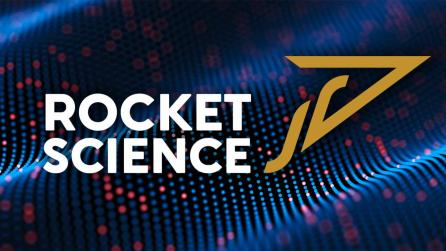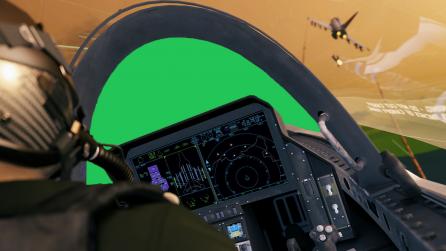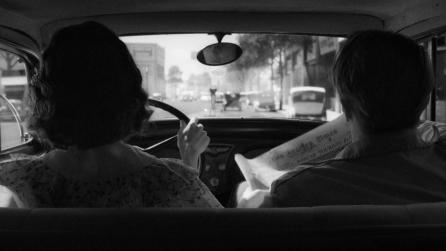Visual effects (VFX) attracts creatives from all walks of life.
At any age and from any background, artists can find a career where they thrive, and our Artist Spotlight series isn’t the only project fascinated by the range and diversity of VFX artists’ careers.
We caught up with Kofi Opoku-Ansah and Daniel Mark Miller, co-hosts of The VFX Artists Podcast, who interview VFX artists at various stages of their careers and across departments to shine a light on the different paths and opportunities careers in VFX can offer. Exploring guests’ journeys, telling funny stories, and giving advice about getting into VFX and how the industry works, Kofi and Daniel are breaking down the barriers to VFX.
Kofi came to the industry in 2011, studying Animation at university and developing a taste for VFX through roles at The Mill, Framestore, Freefolk and Glassworks before going freelance in early 2018. He’s worked with amazing studios in London and across Europe, and on shows such as Marvel’s Shang-Chi and the Legend of the Ten Rings, Eternals, The Witcher Season 2, Maleficent: Mistress of Evil, The Witches, Watchmen and more!
Daniel’s journey into VFX, by his own admission, was much longer. Having studied Media Production, he bounced around between directing, screenwriting, and lighting before moving to Italy to teach English. It was while in Italy that he picked up some VFX skills working on his own short films and taking on little bits of corporate work. He took an online VFX course, and has never looked back! He’s worked on huge shows like Good Omens, Baby Driver, Yardie, The Crown and many more.
We sat down with them both to discuss the podcast, past and future projects, the role Nuke plays in both artists’ creations and grab some top tips for breaking into the VFX industry.

Can you tell us about how you met and how you started working together?
DM: Funnily enough we still haven’t met in person! That should change soon with nicer weather and an end to lockdowns. We “met” because I started following the podcast and began chatting to Kofi about it on LinkedIn as I had a similar podcasting idea but Kofi got up and did it first. When Kofi had his second child, he reached out to me to help out on the podcast. Having two of us has really boosted our capabilities as we are both full-time VFX artists and parents!
KO: I’m sure we will celebrate with a photo when we finally meet!
Apart from the podcast, is there a piece of work or project you’ve worked on that you’re particularly proud of?
KO: It’s very difficult to choose between your kids! I’m proud of every show I’ve had the privilege of working on, but if I had to choose one, I’d say the VFX on Marvel’s Eternals—it’s one of the projects I’m most proud of contributing to.
DM: I still really love Matteo Garrone’s Pinocchio. I think it’s really exciting when any art film, European film or something outside the Hollywood mainstream gets the budget to do VFX. Even jaded artists get excited and do great work with limited resources. Other than that, the last film I worked on at Framestore before leaving was like nothing I have ever worked on before—can’t say much more but it was a ride!


Can you talk us through the process of finding people to interview on your podcast?
DM: There’s such a mix. There are people we know well and have worked with, who we know would be great to get on, like with Arpita and Christy. Some get recommended through our network, like Chris Nicolls and some are people I have been following on social media and reach out to, such as Carolina. Most excitingly, we are starting to get people reaching out with a story to tell on the podcast. For me, that’s the biggest leap!
KO: Sometimes we will pick a topic and find artists who may be interested in discussing it, but because we strive to feature and highlight diverse artists, regardless of seniority level or department, we’re always coming across new amazing artists organically.
What is your favorite question to ask guests on the podcast? Why?
DM: It’s got to be asking how they got their start - the answers are never the same. People have come from all walks of life and via all sorts of paths into the industry, so it brings up some interesting answers!
KO: I agree with Dan on that! Another one I like is asking artists from diverse backgrounds about what their parents think about their career choice. I find it fascinating that often these parents have discouraged their children from entering the creative industry, thinking that VFX and creative pathways generally aren’t able to provide a secure future when compared with more traditional careers.

Out of all your great guests on the podcast, who were you most excited to interview and why?
KO: The very first person on the episode, Ace Ruele, was extra exciting. Partly of course because he was the first, but mostly because Ace is an incredibly hard-working motion capture artist, with great passion for what he does and a great reputation, so it was simply mind-blowing just to have him discuss what he does.
DM: I’ve been excited to meet all the guests, so it’s a little unfair to make me pick! I guess Chris Nicholls, who was my first interview. I was a bit nervous not to mess it up as Kofi had entrusted me with this thing he had spent so much time building up!
Has there ever been anything or anyone that surprised you on the podcast? Any stories you can share?
KO: Episode thirteen with Simon Legrand, real-time Supervisor at Untold Studios, was one full of incredible and surprising moments. Simon’s journey working at some of the big studios in the industry also led to some personal challenges due to industry culture at the time and it was just incredible how he overcame it all. Worth a listen!
DM: I was quite surprised that Christy Anzelmo started in fashion design! I’ve also been surprised by the ways VFX software is used outside of visual effects, for example in product design and testing, Nuke is used in car showrooms to spec vehicles.

Kofi, could you tell us how you use Nuke day-to-day as a freelancer? How and when did you start learning it?
KO: I’ve been using Nuke since 2013, and for the most part, being a 3D artist and predominantly now as a Freelance Matchmove artist, my use case with Nuke is quite limited. Most of my time in Nuke usually is used to do basic 3D pre-comps when needed, getting metadata from plates, or sometimes spitting out modified versions of the plate for use in Matchmove. My favorite is creating a high pass filtered plate for the times when every detail is crucial for a camera or object tracking.
Do you find that working freelance means you build up a wider network in the industry?
KO: Completely! It’s a beautiful thing. Being a freelancer allows me to meet so many different and incredible artists of all levels and departments, and it also allows me to build different quality tolerances at each studio, which is great! It forces me to always improve, and gain new skills from the experience and quality of work from other studios. The bonus, of course, is the increase in my industry network.

Daniel, as a Senior Compositor, could you tell us about your use of Nuke? How and when did you start learning it?
DM: I try to use a good mix of tried and tested workflows/templates (for efficiency!) but also to stay current with new workflows as they arise. I guess it’s about knowing when something like Deep compositing is going to speed you up and bring higher quality and when it’s going to slow you down.
I had been using After Effects on my own short films and was loving compositing, so I started asking around online about what the professional industry was looking for. Following that advice, I learned Shake. Apple gave up on it by the time I was getting to grips with it, and Nuke was the obvious answer. This was around 2009, or Nuke 6.0. Now, I use Nuke for all my compositing, especially shots that are complex; in a collaborative environment, it’s unrivaled really. The only thing I don’t use it for is the podcast—although I did composite the ident text on the pier in Nuke!
What is your favorite feature of Nuke and why?
DM: Copy-pasting nodes! I mean it’s pretty basic but it really helps when sharing workflows and ideas that you can just copy a set-up, message it to someone and they can paste it into their script and it works. It really helps explain new ideas, whether you’re learning Nuke, matching a look between shots or trying to get into a new feature set. I love how the new features like CopyCat are still based around the idea of sharing workflows between artists.

Do you have any wider tips for artists looking to break into the VFX industry?
DM: If you can grab an apprenticeship, do—they are such a strong way into the industry. Otherwise, it’s about building your reel and network. Don’t try to do too many things. Something simple but perfectly executed looks way more professional than a super ambitious shot executed poorly.
For comp, learn about photography, watch a lot of films—not just new, franchise movies—stay curious, learn about traditional art and design. Master a speciality but learn about other roles in the industry. Never be arrogant or think you know everything because you don’t. Collaborate because you can‘t do this stuff on your own. Listen to the stories of artists doing what you want to do…maybe on our podcast!
KO: Yes, I’m with Dan on this. I’m a big advocate for seeking as much work experience as possible, especially when you’re unsure about which industry or department to go into. Don’t limit yourself—a variety of experiences only serves to open doors for the future.

What type of opportunities should artists be looking out for? How important is it to network and build connections?
DM: Building connections is super important, but remember this isn’t nepotism—no-one is recommending you because they like you and have a connection. You have to have the skills; a network forms from colleagues who can vouch for your work and your attitude. Your peers are your most important contacts. And it cuts both ways—do shoddy work, be rude or unpleasant and that reputation will follow you around the world!
How has the pandemic affected your compositing work? Do you think there will be any changes to how people work in the industry going forward?
DM: Work from home is here to stay! No-one I have spoken to wants to commute five days a week. There are advantages to going into the office but we’ve proven that work from home delivers, the work/life balance is so much better to the point where it’s often more productive.
Are there any upcoming trends within the VFX industry that you are particularly excited about?
DM: Machine learning and real-time have to be the biggies. We’ve got to speak to a lot of artists about real-time on the podcast and you can see that it means a lot of changes. It’s creating more work before the shoot, although it doesn’t seem to have reduced work in post yet—at least on bigger movies. Perhaps for real-time to reach its full potential filmmakers need a change of mindset where they lock into decisions much sooner. That’s kind of the opposite to what digital has created where filmmakers can make changes later and later down the pipeline.

What does the future look like for you both? Any plans for the podcast or personal projects that you can tell us about?
DM: As well as growing the podcast, I’ve got a short film project which has been on the backburner for a while. The main asset is being worked on by Angel Cano with support from Cave Academy and then we’ll get a shoot together and go go go. For the podcast, we’re hoping to expand it to a much wider audience, and we are playing with some additional formatting ideas, alongside the interviews.


KO: As Daniel mentioned, we are constantly working to improve the quality and format of the podcast. What’s absolutely certain, though, is that it will always be diverse, and we intend to keep it inspirational and light, while covering technical points when we need to.
Regarding personal projects, I also have a short film that I’d like to have out by the end of 2022 or 2023. It’s currently still in the early stages, but I feel it’s going to be very interesting and a great learning experience for me. Stay tuned!


